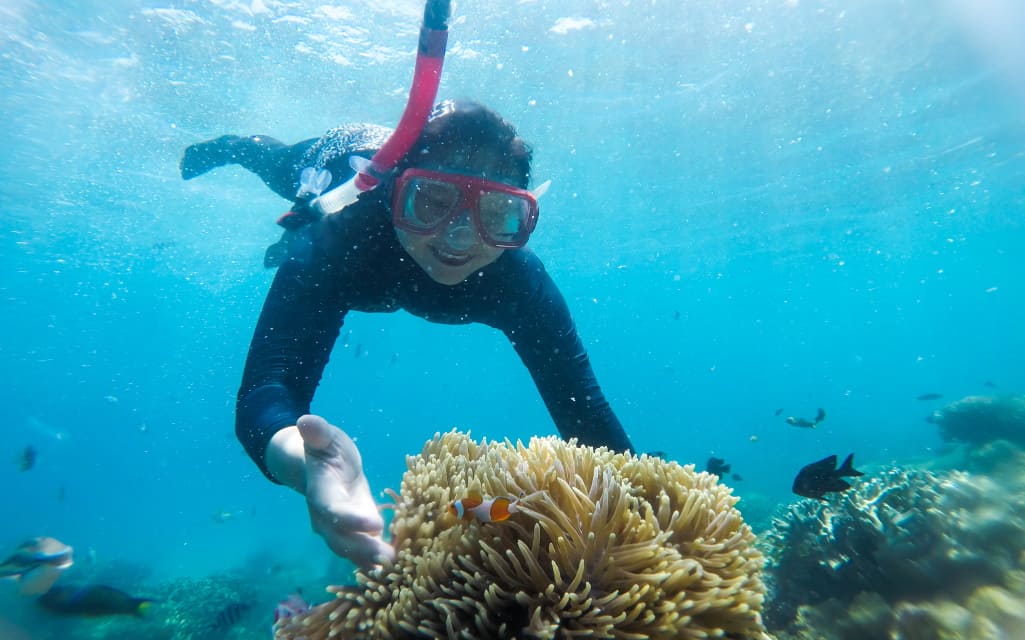If you have yet to discover the amazing world of snorkeling, you are in for a treat. It completely changes everything when you can breathe in the water and with a good pair of flippers, there isn’t much you can’t do. If you are new to snorkeling, here is our beginner’s guide to help you master the art.
Snorkelling Equipment
There are 3 items you need;
- Face mask – Good quality goggles that cover the eyes and nose.
- Snorkel (a U-shaped pipe) with rubber band to attach the device to your face mask.
- Pair of fins (flippers) – For propulsion and buoyancy on the surface.
For affordable quality, check out Decathlon’s snorkeling masks for adults and kids, plus you’ll save 15-20% on recommended retail prices. Shopping online makes total sense and you can get everything you need from a single online provider. If you buy the best quality, your snorkeling gear will last you a lifetime and the online supplier has the best deals.
Swimming
When performing the crawl, you no longer have to tilt your head to one side, which makes is easier to regulate your breathing. Focus on your feet, with regular up and down movement that is controlled from the thighs. Once you get the hang of it, you can swim for a long time; even floating on your front and resting. As with most things, the more you snorkel, the better you become, practice makes perfect, as they say. A good swimmer can swim indefinitely with fins and a snorkel, but do take care if you are thinking of going out a considerable distance from your station, as this could lead to disaster.
Short Dives
Take in a deep breath and push yourself downwards and use your flippers to drive you, and, of course, remember to resurface for breath. You can comfortable go down 5-10m, which gives to a chance to inspect the coral and the diverse marine life it houses.
Safety
Of course, you should never stray too far from the boat or shoreline and always know about tides, which could literally sweep you out to the open ocean. When exploring the coral, resist the temptation to put your hands inside coves and concealed corners, as eels and other predatory species hide there and might attack if cornered. Stay away from sea snakes, as most are highly venomous, although there are not aggressive with humans; avoid any snakes you encounter in the ocean. Of course, you must always stay hydrated, so make sure you drink lots of water.
Sunburn
Laying on the surface for long periods can lead to sunburn, so you are advised to wear a T-Shirt when snorkeling, plus put sunscreen (waterproof) on your shoulders and legs. This is particularly important if you have fair skin and are on holiday in a tropical destination, as the salty air also promotes sunburn.
Be Calm & Relaxed
Think of it this way; your body floats and with a pipe that allows you to breathe, you should not get into difficulties. Always stop and check exactly where you are, as currents can take you along without you realising. Use your flippers to keep you above the water when vertical and any time you need a rest, simply lay on your front and breathe normally.
Footwear
You might think you can do away with the fins and walk on the bottom, yet this is very dangerous, so if you are not wearing fins, wear some rubber shoes. Walking around in coral waters is never a good idea without protective footwear. The stonefish, for example, possesses a very venomous set of spikes and should you tread on it with bare feet, it could be fatal.
If you invest in an underwater camera, you can record your amazing expeditions over and near coral reefs. The best places to snorkel include the Red Sea and the South of Thailand and do take care to follow the eco advice from the boat captain. We are not allowed to take coral, or indeed anything from a reef, otherwise serious damage would occur.



